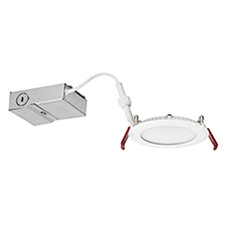
LEDs Have Things Looking Up for Downlights
Chuck Ross
Look up in most U.S. kitchens and you’ll likely see recessed downlights shining back at you. These fixtures have been the go-to option for decades – not just in kitchens, but throughout the house – for providing area lighting that doesn’t interrupt a ceiling’s clean lines. However today’s models have come a long way from the can-style designs back in the pre-LED days. They’ve slimmed down in size while beefing up on features, making them an even more useful tool in a lighting designer’s bag of tricks.
These luminaires have an interesting origin story; they were first developed to deliver focused light to church congregants because inadequate chandelier-supplied illumination was forcing them to squint at their prayer books and hymnals. From there, these lighting fixtures made their way into homes, offices, and retail settings, gaining new options like baffles and lenses for customized designs that could help direct light right where it was needed.
LEDs have brought new affordability and performance to this category, offering high-efficiency light sources that generate little heat and providing controllability that gives designers, homeowners, and building managers new ways to use light in interior spaces. You can realize some of these benefits by simply switching from metal halide or compact fluorescent lamps to LED products in existing luminaires. But in renovation or new construction projects, new fixtures with LED light sources integrated directly into the housing are more like flat discs than coffee cans because they don’t have to accommodate separate lamps. Electricians don’t have to worry about the location of joists for mounting these new profiles – instead, they can snap into place using simple spring clamps that help them fit snugly against the ceiling’s drywall.
These luminaires have an interesting origin story; they were first developed to deliver focused light to church congregants because inadequate chandelier-supplied illumination was forcing them to squint at their prayer books and hymnals. From there, these lighting fixtures made their way into homes, offices, and retail settings, gaining new options like baffles and lenses for customized designs that could help direct light right where it was needed.
Older lighting sources, though, created a lot of heat that could become trapped in the fixtures’ metal housings. The cans could get hot enough to cause surrounding ceiling insulation to combust, which meant specific installation approaches were needed when insulation was being used. Fire-rated designs helped address this issue, but they also added to fixture cost, turning a once-affordable lighting choice into a more expensive consideration.
Photo courtesy of Lithonia Lighting



